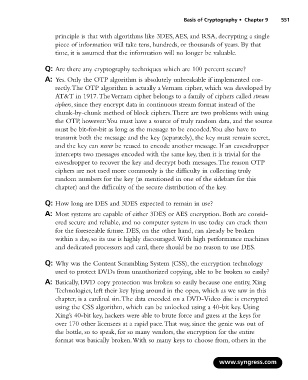Page 567 - StudyBook.pdf
P. 567
Basis of Cryptography • Chapter 9 551
principle is that with algorithms like 3DES,AES, and RSA, decrypting a single
piece of information will take tens, hundreds, or thousands of years. By that
time, it is assumed that the information will no longer be valuable.
Q: Are there any cryptography techniques which are 100 percent secure?
A: Yes. Only the OTP algorithm is absolutely unbreakable if implemented cor-
rectly.The OTP algorithm is actually a Vernam cipher, which was developed by
AT&T in 1917.The Vernam cipher belongs to a family of ciphers called stream
ciphers, since they encrypt data in continuous stream format instead of the
chunk-by-chunk method of block ciphers.There are two problems with using
the OTP, however:You must have a source of truly random data, and the source
must be bit-for-bit as long as the message to be encoded.You also have to
transmit both the message and the key (separately), the key must remain secret,
and the key can never be reused to encode another message. If an eavesdropper
intercepts two messages encoded with the same key, then it is trivial for the
eavesdropper to recover the key and decrypt both messages.The reason OTP
ciphers are not used more commonly is the difficulty in collecting truly
random numbers for the key (as mentioned in one of the sidebars for this
chapter) and the difficulty of the secure distribution of the key.
Q: How long are DES and 3DES expected to remain in use?
A: Most systems are capable of either 3DES or AES encryption. Both are consid-
ered secure and reliable, and no computer system in use today can crack them
for the foreseeable future. DES, on the other hand, can already be broken
within a day, so its use is highly discouraged.With high performance machines
and dedicated processors and card, there should be no reason to use DES.
Q: Why was the Content Scrambling System (CSS), the encryption technology
used to protect DVDs from unauthorized copying, able to be broken so easily?
A: Basically, DVD copy protection was broken so easily because one entity, Xing
Technologies, left their key lying around in the open, which as we saw in this
chapter, is a cardinal sin.The data encoded on a DVD-Video disc is encrypted
using the CSS algorithm, which can be unlocked using a 40-bit key. Using
Xing’s 40-bit key, hackers were able to brute force and guess at the keys for
over 170 other licensees at a rapid pace.That way, since the genie was out of
the bottle, so to speak, for so many vendors, the encryption for the entire
format was basically broken.With so many keys to choose from, others in the
www.syngress.com

